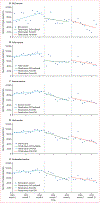Effect of Ebola virus disease on maternal and child health services in Guinea: a retrospective observational cohort study
- PMID: 28237252
- PMCID: PMC6530984
- DOI: 10.1016/S2214-109X(17)30078-5
Effect of Ebola virus disease on maternal and child health services in Guinea: a retrospective observational cohort study
Abstract
Background: The 2014 west African epidemic of Ebola virus disease posed a major threat to the health systems of the countries affected. We sought to quantify the consequences of Ebola virus disease on maternal and child health services in the highly-affected Forest region of Guinea.
Methods: We did a retrospective, observational cohort study of women and children attending public health facilities for antenatal care, institutional delivery, and immunisation services in six of seven health districts in the Forest region (Beyla, Guéckédou, Kissidougou, Lola, Macenta, and N'Zérékoré). We examined monthly service use data for eight maternal and child health services indicators: antenatal care (≥1 antenatal care visit and ≥3 antenatal care visits), institutional delivery, and receipt of five infant vaccines: polio, pentavalent (diphtheria, tetanus, pertussis, hepatitis B virus, and Haemophilus influenzae type b), yellow fever, measles, and tuberculosis. We used interrupted time series models to estimate trends in each indicator across three time periods: pre-Ebola virus disease epidemic (January, 2013, to February, 2014), during-epidemic (March, 2014, to February, 2015) and post-epidemic (March, 2015, to Feb, 2016). We used segmented ordinary least-squares (OLS) regression using Newey-West standard errors to accommodate for serial autocorrelation, and adjusted for any potential effect of birth seasonality on our outcomes.
Findings: In the months before the Ebola virus disease outbreak, all three maternal indicators showed a significantly positive change in trend, ranging from a monthly average increase of 61 (95% CI 38-84) institutional deliveries to 119 (95% CI 79-158) women achieving at least three antenatal care visits. These increasing trends were reversed during the epidemic: fewer institutional deliveries occurred (-240, 95% CI -293 to -187), and fewer women achieved at least one antenatal care visit (-418, 95% CI -535 to -300) or at least three antenatal care visits (-363, 95% CI -485 to -242) per month (p<0·0001 for all). Compared with the negative trend during the outbreak, the change in trend during the post-outbreak period showed that 173 more women per month (95% CI 51-294; p=0·0074) had at least one antenatal care visit, 257 more (95% CI 117-398; p=0·0010) had at least three antenatal care visits and 149 more (95% CI 91-206; p<0·0001) had institutional deliveries. However, although the numbers for these indicators increased in the post-epidemic period, the trends for all stagnated. Similarly, the increasing trend in child vaccination completion during the pre-epidemic period was followed by significant immediate and trend reductions across most vaccine types. Before the outbreak, the number of children younger than 12 months who had completed each vaccination ranged from 5752 (95% CI 2821-8682) for tuberculosis to 8043 (95% CI 7621-8464) for yellow fever. Immediately after the outbreak, significant reductions occurred in the level of all vaccinations except for yellow fever for which the reduction was marginal. The greatest reductions were noted for polio and tuberculosis at -3594 (95% CI -4811 to -2377; p<0·0001) and -3048 (95% CI -5879 to -216; p=0·0362) fewer vaccines administered, respectively. Compared with pre-Ebola virus disease outbreak trends, significant decreases occurred for all vaccines except polio, with the trend of monthly decreases in the number of children vaccinated ranging from -419 (95% CI -683 to -155; p=0·0034) fewer for BCG to -313 (95% CI-446 to -179; p<0·0001) fewer for pentavalent during the outbreak. In the post-Ebola virus disease outbreak period, vaccination coverage for polio, measles, and yellow fever continued to decrease, whereas the trend in coverage for tuberculosis and pentavalent did not significantly differ from zero.
Interpretation: Most maternal and child health indicators significantly declined during the Ebola virus disease outbreak in 2014. Despite a reduction in this negative trend in the post-outbreak period, the use of essential maternal and child health services have not recovered to their pre-outbreak levels, nor are they all on a course that suggests that they will recover without targeted interventions.
Funding: University of Conakry and Centre National de Formation et Recherche de Maferinyah (Guinea).
Copyright © 2017 The Author(s). Published by Elsevier Ltd. This is an Open Access article under the CC BY-NC-ND license. Published by Elsevier Ltd.. All rights reserved.
Conflict of interest statement
Declaration of interests
We declare no competing interests.
Figures



Comment in
-
The end of the Ebola virus disease epidemic: has the work just begun?Lancet Glob Health. 2017 Apr;5(4):e381-e382. doi: 10.1016/S2214-109X(17)30079-7. Epub 2017 Feb 23. Lancet Glob Health. 2017. PMID: 28237251 No abstract available.
References
-
- Countdown to 2015. Country profiles, 2015. http://www.countdown2015mnch.org/country-profiles (accessed Sept 5, 2016).
-
- Delamou A, Hammonds RM, Caluwaerts S, Utz B, Delvaux T. Ebola in Africa: beyond epidemics, reproductive health in crisis. Lancet 2014; 384: 2105. - PubMed
-
- Menendez C, Lucas A, Munguambe K, Langer A. Ebola crisis: the unequal impact on women and children’s health. Lancet Glob Health 2015; 3: e130. - PubMed
-
- Black BO. Obstetrics in the time of Ebola: challenges and dilemmas in providing lifesaving care during a deadly epidemic. BJOG 2015; 122: 284–86. - PubMed
-
- Ministry of Finance Planning and Economic Development and Government of Uganda. Poverty strategy paper: Uganda’s Poverty Eradication Action Plan, 2000. Kampala, Uganda: http://siteresources.worldbank.org/INTPRS1/Resources/Country-Papers-and-... (accessed Nov 10, 2016).
Publication types
MeSH terms
Grants and funding
LinkOut - more resources
Full Text Sources
Other Literature Sources
Medical

